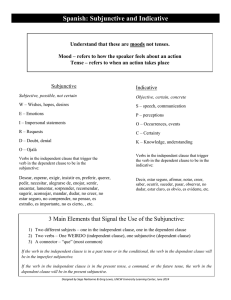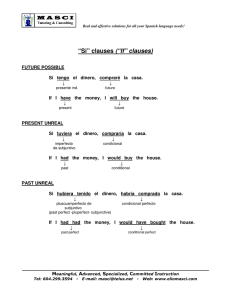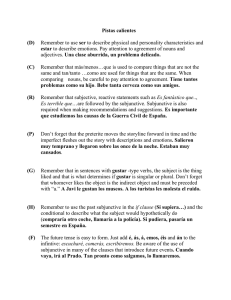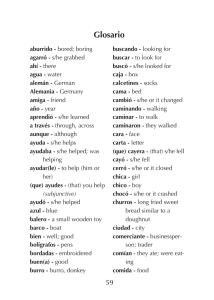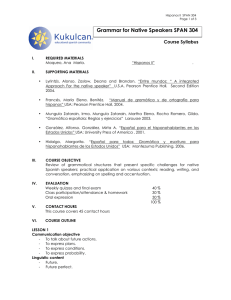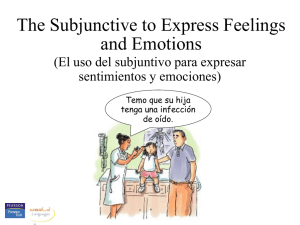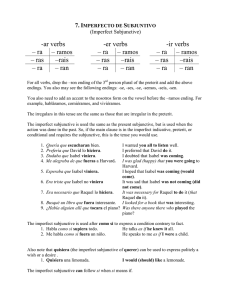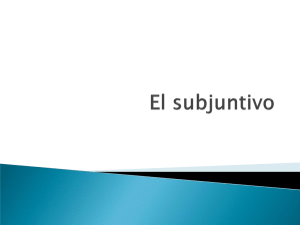Laca (2014) (Temporal Orientation & the Semantics of Attitude Verbs)
Anuncio
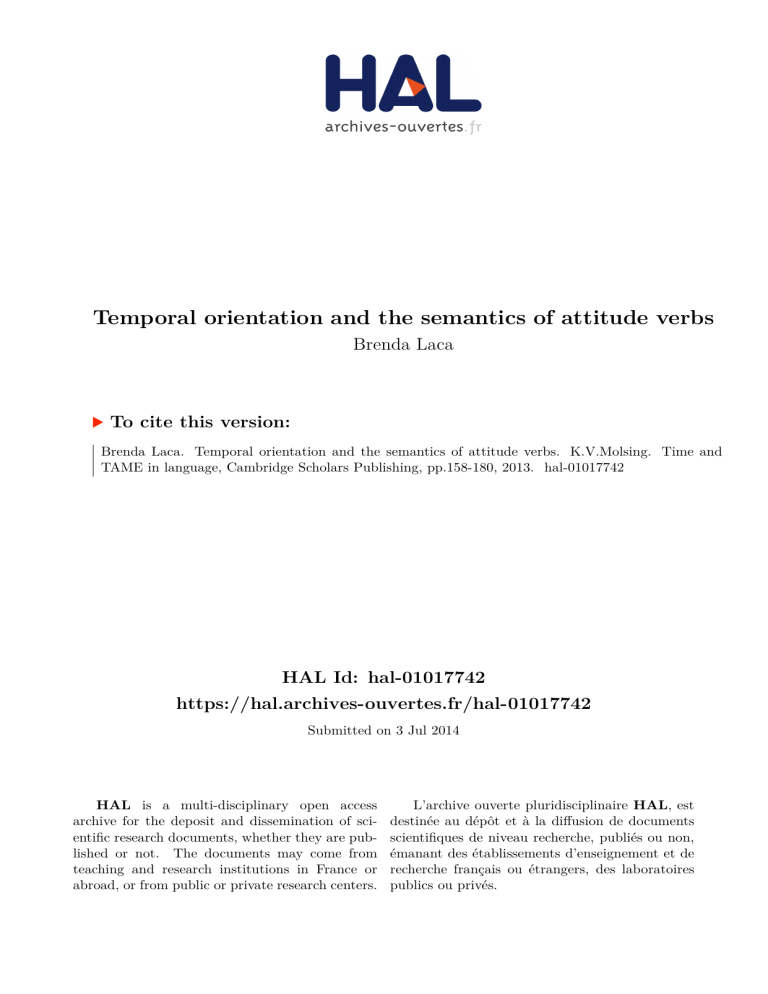
Temporal orientation and the semantics of attitude verbs Brenda Laca To cite this version: Brenda Laca. Temporal orientation and the semantics of attitude verbs. K.V.Molsing. Time and TAME in language, Cambridge Scholars Publishing, pp.158-180, 2013. �hal-01017742� HAL Id: hal-01017742 https://hal.archives-ouvertes.fr/hal-01017742 Submitted on 3 Jul 2014 HAL is a multi-disciplinary open access archive for the deposit and dissemination of scientific research documents, whether they are published or not. The documents may come from teaching and research institutions in France or abroad, or from public or private research centers. L’archive ouverte pluridisciplinaire HAL, est destinée au dépôt et à la diffusion de documents scientifiques de niveau recherche, publiés ou non, émanant des établissements d’enseignement et de recherche français ou étrangers, des laboratoires publics ou privés. 1 [in Time and TAME in Language, ed. by K.V. Molsing & A. Tramunt Ibaños, Cambridge Scholars Publishing 2013. 158‐180] Brenda Laca CNRS UMR 7023 Structures formelles du langage Université Paris 8 CHAPTER XX TEMPORAL ORIENTATION AND THE SEMANTICS OF ATTITUDE VERBS This paper reports on work in progress in a particularly complex area of the syntax‐ semantic interface, that of the typology of argument clauses and of the predicates that embed them. One aspect of this well belabored field has been rather neglected up to the present, namely the constraints on temporal orientation that different types of predicates impose on their argument clauses. I believe that a systematic exploration of these constraints is crucial for the development of a finer‐grained typology. Though plausibly universal, such constraints as there are emerge more clearly in languages with a a rich overt system of indicative and subjunctive tenses and viewpoint aspects, such as Spanish, and they are less obvious in languages with a temporally impoverished subjunctive mood (as for instance French, German or English). Throughout the article, I will be using the label “attitude verb” in a rather loose way, extending it to performatives. Recent work on attitude verbs suggests that a uniform, Hintikkian treatment of “attitudes of belief” and “attitudes of desire” does not do justice to some deep‐entrenched semantic and syntactic differences between the two types of attitudes. So, for instance, Anand and Hacquard (2009) distinguish attitudes of acceptance, which have or operate on propositional contents, on the one hand, from attitudes of preference, which assert an ordering among alternatives, on the other hand. This tradition, as far as I can tell, goes back at least to the work of the philosopher Anthony Kenny (1963), via Stalnaker (1984) on desires and Heim’s (1992) “ordering semantics” for wishes. Anand and Hacquard stress a clear distributional difference between attitudes of acceptance and attitudes of preference: as shown in (1a‐b) and (2a‐b) the former, but not the latter, allow for epistemic interpretations of modals and for epistemic adverbs in their argument clauses. 1. a. Mary believes/assumes/claims that Peter might come to the party. b. #Mary wishes/requests that Peter might come to the party. 2 2. a. Mary believes/assumes/claims that Peter will perhaps come to the party. b. #Mary wishes/requests that Peter perhaps come(s) to the party. Attitudes of acceptance comprise verbs of belief and assertion, attitudes of preference comprise bouletic and directive verbs. The complementation patterns of these two types of attitude predicates differ in various ways in language after language. Roughly, in Romance we have mood differences in the argument clause, as shown in (3a‐b) for French, with attitudes of acceptance taking the indicative, and attitudes of preference taking the subjunctive in their argument clauses.i In German, V2 complementation is restricted to attitudes of acceptance (4a‐b), cf. Meinunger (2005). In English, attitudes of acceptance take indicative that­ clauses or AcI‐infinitives (5a), whereas attitudes of preference are the domain of control or so‐called for...to‐infinitives (5b), cf. Portner (2007). I am not implying that these contrasts are sensitive to exactly the same factors, but they do overlap to a considerable extent, and they show that the difference between the two types of attitude has clear syntactic correlates. 3. a. Mary croit/ suppose/ affirme que Pierre viendra à la fête. Mary believes/supposes/ claims that Pierre come.FUT.IND to the party ‘Mary believes/ supposes/ claims that Pierre will come to the party’ [FRENCH] b. Mary souhaite/demande que Pierre vienne à la fête. Mary wishes/ requests that Pierre come.SUBJ to the party ‘Mary wishes/ requests that Pierre (should) come to the party’ 4. a. Mary glaubt/ nimmt an/behauptet, Pierre kommt zur Party. Mary believes/supposes/ claims Pierre comes to the party ‘Mary believes/ supposes/ claims that Pierre will come to the party’ b. *Mary möchte/bittet, Pierre kommt zur Party. Mary wishes/requests Pierre comes to the party 5. a. Mary believes/claims Pierre to be an impostor. b. Mary wishes for/asked (for) Pierre to leave the room. [GERMAN] Although the temporal orientation of argument clauses is often attributed to the semantics of individual lexical verbs, a clear, but complex correlation will be shown to exist between attitudes of preference and future temporal orientation. This correlation is complex because it takes different forms depending on the different semantic subtypes of 3 attitudes of preference, and thus contributes to motivate a finer‐grained typology of such attitudes. Let us start by defining temporal orientation as the relationship between the time of the argument clause and the time of the matrix clause.ii In a neo‐Reichenbachian framework such as adopted here (see Demirdache & Uribe‐Etxeberria 2008, Laca 2010) the notion of “time of a clause” is systematically ambiguous, since it may refer either to the Assertion Time (AST‐T) or to the Event Time (EV‐T) of the clause. We will take it for granted that the anchor for temporal orientation in argument clauses is always the AST‐T of the matrix clause (TMATRIX). As for the time of the argument clause itself, we will see that both its AST‐T and its EV‐T have to be taken into consideration when exploring the constraints on temporal orientation. We make the standard assumption that AST‐T and EV‐T are disjoint in the case of perfect or anterior aspect, where EV‐T precedes AST‐T, and in the case of prospective aspect, where EV‐T follows AST‐T. The observation that the argument clauses of attitudes of preference have a future temporal orientation is recurrent in the literature. This has been explicitly claimed of the argument clauses of predicates triggering “intensional” (≈ optative) subjunctives in Romance. (Kempchinski 1986, 2009, Quer 1998, among many others). In fact, future orientation is taken to be one of the properties distinguishing “intensional” from “polarity” (≈ dubitative) subjunctives. This claim is based on contrasts such as that illustrated in (6a‐ b). 6. a. Juan dudaba que María estuviera en casa cuando llegó la carta. J. doubt.IMPF.IND that M. be.IMPF.SBJ in house when arrive.SP the letter ‘Juan doubted that María was at home when the letter arrived’ b.*Juan quería que María estuviera en casa cuando llegó la carta. J. want.IMPF.IND that M. be.IMPF.SBJ in house when arrive.SP the letter #‘Juan wanted María to have been at home when the letter arrived’ Both (6a) and (6b) contain a past form in their subjunctive complement clause. The temporal configuration imposed by this past form in connection with the embedded temporal adjunct clause is represented under (7). 7. [letter­arrive]EvT=AstT ‐‐‐‐‐‐‐‐‐‐‐‐‐‐‐‐‐‐‐‐‐[Mary­be­at­home]EvT‐‐‐‐‐‐‐‐‐‐‐‐‐‐Tmatrix‐‐‐‐‐‐‐‐UttT “POLARITY” SUBJUNCTIVE: OK “INTENSIONAL” SUBJUNCTIVE: * 4 Both the AST‐T of the complement clause, as identified by the temporal adjunct clause, and its EV‐T strictly precede TMATRIX. This temporal configuration is acceptable for a matrix verb as dudar ‘doubt’, which as a ‘belief’‐verb represents an attitude of acceptance, but it is excluded for querer ‘want’, which exemplifies an attitude of preference. While a “polarity” subjunctive admits strict precedence of the time of the argument clause, i.e. a past temporal orientation, this orientation seems excluded in the case of “intensional” subjunctives. The fact that strict precedence is out can be taken at least as an indication of a ban on past orientation for attitudes of preference. What appears in Spanish as a contrast between acceptable and unacceptable sequences of tenses appears in a slightly different guise as an interpretive phenomenon in English. A look at the contrast between ‘belief’‐verbs taking AcI or “raising” infinitives, and “preference” verbs taking for…to or control infinitives shows that the latter, but not the former, admit future oriented adverbials. This is illustrated by the unacceptability of (8a) versus the full acceptability of (8b): 8. a. Mary believed Peter to be at the station (*later that night). b. Mary wanted Peter to be at the station later that night. In this case, attitudes of acceptance are incompatible with a future temporal orientation, whereas attitudes of preference seem to impose such a temporal orientation. In fact, it is widely assumed that the argument clauses of verbs embedding control/ for…to infinitives are future oriented (Portner 1997, Cornilescu 2004). Strengthening the correlation between attitudes of preference and future (or at least non‐past) orientation, the same type of temporal orientation has been attributed to a main sentence type, namely imperative sentences (Schwager 2008 among many others). And precisely, imperative sentences can be fruitfully analysed as assertions of preferences (Condoravdi & Lauer 2009, 2010). Given this clear correlation between attitudes of preference and future or non‐ anterior temporal orientation, the question then arises as to the exact relationship between preference semantics and “future orientation” and the reasons for this relationship. In what follows, I will contend that future orientation is one possible way of satisfying a semantic constraint or a presupposition of φ ‐diversity on modal bases (sets of accessible 5 worlds). This constraint requires that the domain of quantification contain both φ and ¬φ worlds and is operative in all contexts involving ordering of worlds (Heim 1992, Condoravdi 2001, Werner 2003). In a branching‐future model, future orientation satisfies this constraint via the notion of historical contingency: at the time of evaluation set by TMATRIX both φ and ¬φ worlds are possible future continuations of an equivalence class of worlds that are indistinguishable up to TMATRIX. This is, however, not the only way of satisfying the φ ‐ diversity constraint. Doxastic uncertainty of an epistemic agent as to a decided matter also warrants φ ‐diversity and is not grounded in a distinction between non‐future and future alternatives. Furthermore, widening the modal base by encompassing discarded alternatives – a move that is normally signalled by dedicated morphology on the matrix verb‐ can also contribute to establish φ ‐diversity in the absence of historical contingency or doxastic uncertainty. Interestingly enough, we will see that future orientation is categorical for the contents of directive speech acts, and for the argument clauses reporting the contents of such acts (Schwager 2008, Condoravdi & Lauer 2009). Imperative mood, which is at least prototypically linked to directive speech acts, lacks past tense forms, and its present is “forward‐shifted”. This very robust future orientation seems to be a consequence of the fact that directives enter into the logic of action and causation in a way in which mere preferences do not. 2. Previous approaches: unifying the contents of attitudes of preference under imperatives There is a further widespread intuition in the literature, namely, that the same solution that works for the analysis of the argument clauses of directives and bouletics (the two main attitudes of preference) should also work for imperative sentences. Directives normally report imperative sentences, and the complementation patterns of bouletics look very much like those of directives. Acting on this intuition, several proposals have attempted to unify the content of the argument clauses of attitudes of preference (directives and bouletics) under imperatives. So, for instance, Kempchinski (1986, 2009) hypothesizes that the complement clauses of bouletics and directives contain an imperative‐like operator that ensures future‐orientation. Nonetheless, in the absence of a precise semantics for this imperative‐like operator, this does not help us much further. There is , however, a more precise version of the same general approach. It is the idea, inspired by Portner (1997) and subsequently taken up by Ginzburg & Sag (2001), that 6 directives and bouletics embed the same type of semantic object that is denoted by the descriptive content of an imperative sentence. Crucially, this type of object is not a proposition, i.e. it is not a set of possible worlds as complete world histories. It is a “smaller” object, a situation which constitues the future extension of a reference situation, or, in the terminology of Ginzburg & Sag, an “outcome”, i.e. the specification of a futurate situation, an eventuality ensuing from a cause or targeted by a disposition or a “plan” for future action. Notice that this family of approaches, which I call “unifying under imperatives”, take the intuition of future orientation at face‐value, so to say, and they build it per definition into the semantics of complements of attitudes of preference. The intuition of future orientation leads –without much questioning‐ to the introduction of a new type of semantic object in the ontology, outcomes. Setting aside the fact that such approaches do not explain future orientation, but build it –with some circularity‐ into the semantics of the complements of attitudes of preference, they make a very clear prediction as to the temporal orientation of attitudes of preference: attitudes of preference should have a uniform future orientation, holding for directives and bouletics alike. The question I would like to address now, on the basis of Spanish facts, is whether this prediction holds. 2. The temporal orientation of “intensional” subjunctive clauses 2. 1. Evidence for future orientation I will try to provide an answer to the question formulated above by looking at the temporal orientation of “intensional” subjunctive clauses in Spanish, which are those that appear under attitudes of preference. “Intensional” subjunctives are in fact selected by directive, bouletic (volitional or desiderative)iii, and causative predicates, and they also appear in final adjunct clauses. They are to be distinguished from “polarity” subjunctives, which are licensed (i.e. not selected) in “negative” (downward‐entailing) contexts (for a motivation of this distinction, cf. Quer 1998, 2006). The difference between both types of subjunctive clauses was illustrated above in (6a‐b) by contrasting doubt, which licenses a polarity subjunctive, with want, which selects for an intensional subjunctive.iv In all the examples that follow, intensional subjunctives will be systematically contrasted with polarity subjunctives, in order to show that the phenomenon in question does not stem from subjunctive mood itself, but from the type of embedding context, which determines if we 7 have an intensional subjunctive triggered by an attitude of preference or a polarity subjunctive under an attitude of belief. The surest way to find evidence for the future orientation of intensional subjunctives is to examine licit and illicit combinations of tenses and aspects, and the way the licit combinations are interpreted. There are three telling patterns in which intensional subjunctives differ from polarity subjunctives, and which indicate a peculiar temporal orientation: (i) the impossibility of having a past subjunctive embedded under a non‐past in the matrix sentence, (ii) the incompatibility with prospective aspect, and (iii) the existence of a special double‐access pattern in which a non‐past subjunctive is embedded under a past in the matrix sentence. Subjunctive clauses embedded under an attitude of preference cannot be in the past tense if the matrix clause bears a non‐past tense (9a). By contrast, this combination is perfectly possible for polarity subjunctives (9b). 9. a. *Exigen/Quieren que estuviera en casa. [INTENSIONAL SBJ.] demand/want.PR.IND.3PL that be.IMPF.SBJ.3SG at home *’They demand that s/he was at home’ b. No creen que estuviera en casa. [POLARITY SBJ.] not believe.PR.IND.3PL that be.IMPF.SBJ.3SG at home ‘They don’t think s/he was at home’ Imperfect subjunctives, as the one occurring in (9a‐b), have three different interpretations, only one of which locates the AST‐T of the clause before its anchor, which is invariably TMATRIX in the case of argument clauses (for details, see Laca 2010). This ‘real past’ interpretation is the sole possibility in the configurations (9a‐b), since neither anaphoric nor counterfactual ‘fake past’ interpretations are licensed by the present indicative in the matrix clause (cf. Laca 2010). From the ungrammaticality of (9a), we conclude that attitudes of preference (i.e. directives and bouletics alike) do not permit the AST‐T of their argument clauses to precede TMATRIX. This is clear evidence for the non‐anterior temporal orientation of such contexts. The second piece of evidence is the incompatibility with prospective aspect, which holds for subjunctives embedded under directives and bouletics alike, but does not hold for polarity subjunctives. Prospective aspect is expressed periphrastically by ir + a + Infinitive, roughly equivalent to English “be going to”. As illustrated in (10a‐b), this form is impossible in the argument clauses of attitudes of preference, but it is perfectly possible with a ‘belief’‐ verb. 8 10. a. *Exigen/Quieren/Desean que el artículo [INTENSIONAL SBJ.] demand/want/wish.PR.IND.3PL that the paper vaya a tener veinte páginas. goPR.IND.3SG to have twenty pages *‘They demand/want/wish for the paper to be going to be twenty pages long’ b. No creen que el artículo vaya a tener veinte páginas.[POLARITY SBJ.] not believe.PR.IND.3PL that the paper goPR.IND.3SG to have twenty pages ‘They don’t think that the paper is going to be twenty pages long’ What does this incompatibility tell us about the temporal orientation of attitudes of preference? Prospective aspect locates EV‐T after AST‐T. It is known to be also excluded under (temporally interpreted) future morphology, which itself locates AST‐T after UTT‐T (resp. after TMATRIX in embedded contexts), as shown in (11). 11. *El artículo irá a tener veinte páginas. the paper go.FUT.IND.3SG to have twenty pages *’The article will be going to be twenty pages long’ In fact, the illicit monoclausal temporal configuration in (11), which can be schematically represented as in (12), constitutes a sort of “Future of the Future”. This sort of configuration is extremely rare, if at all attested, in the languages of the world, and its unacceptability is one of the many asymmetries between the organisation of the past and that of the future. 12. UttT/Tmatrix ‐‐‐‐‐‐‐‐Assertion Time‐‐‐‐‐‐‐‐Event Time A plausible explanation for the ban against prospective aspect in the complement of directives and bouletics is that sentences like (10a) replicate the illicit temporal configuration (12) in a biclausal environment. This is a strong and more precise indication of a future temporal orientation for attitudes of preference. At the same time, it suggests that the matrix verb is apt to determine the location of the AST‐T of the argument clause, shifting it forward in time. We will briefly take up this issue at the end of this section, when comparing the future orientation of attitudes of preference with future‐oriented attitudes of acceptance. These first two pieces of evidence for a peculiar temporal orientation of the argument clauses of attitudes of preference concern the location of their AST‐T wrt. the anchor. The ban against a “real past” imperfect subjunctive indicates that AST‐T cannot precede TMATRIX, the ban against prospective aspect suggests that it follows TMATRIX. Interestingly enough, we find parallel constraints for imperatives. Imperatives lack past‐tense forms which could locate 9 AST‐T before UTT‐T, and they are incompatible with prospective aspect (see Bravo & Laca 2011 for a discussion of this constraint). The third piece of evidence is less straightforward. I mention it here because it is seldom noticed and it is likely to have far‐reaching consequences for the system of subjunctive tenses. It consists in the existence of a special double‐access pattern in sentences containing a past tense in the matrix and a non‐past tense in the subjunctive clause. As shown in 13 (a‐b) versus (13c), this configuration is possible when the matrix verb is a directive or a bouletic, but it is ungrammatical with ‘belief’‐verbs. 13. [INTENSIONAL SBJ.] a. Les aconsejó que actúen dentro de la legalidad. them advise.SP.IND.3SG that act.PR.SBJ.3SG inside of the law ‘S/he advised them to act according to the law’ b. ¿Quería Greenpeace que se hable del Banco Mundial ? want.IMPF.IND.3SG Greenpeace that REFL talk.PR.SBJ.3SG of+the Bank World ‘Did Greenpeace want for the World Bank to become a central topic ?’ [POLARITY SBJ.] c.*No creían que el artículo tenga veinte páginas. not believe.IMPF.IND.3PL that the paper have.PR.IND.3SG twenty pages *‘They didn’t think that the paper is twenty pages long’ The interpretation of the configuration exemplified by (13a‐b) gives rise to a double‐access effect: the time of the embedded clause is anchored both to TMATRIX and to UTT‐T. Temporal orientation with regard to UTT‐T is simultaneous or posterior.v Temporal orientation with regard to TMATRIX is posterior, which seems to provide a further indication for the future orientation of directives and bouletics alike. Let me schematically illustrate the temporal interpretations of (13a), whose complement clause admits both a habitual/stative and an episodic/eventive interpretation. 14. a. b. ---------------Tmatrix--------------Utt-T---------------------- stative/habitual SBJ.clause ‘advised’ //////////////////////////////// Ev-TSBJ –clause ‘they act according to the law’ ---------------Tmatrix--------------Utt-T---------------------- eventive SBJ.clause ‘advised’ //////////////////////////////// Ev-TSBJ –clause ‘they act according to the law’ As stated above, this piece of evidence is less straightforward than the two previous results. It is difficult to come up with clear tests showing that the time of advising/of wanting strictly precedes the time of the subjunctive clause. But the very existence of this peculiar double‐ access pattern confirms that there is something special about the temporal orientation of subjunctive clauses embedded under attitudes of preference. 10 2.2. Where directives and bouletics part company: the interpretation of perfect aspect Perfect aspect (haber ‘have’ + Past Participle) introduces an anteriority relation that locates an event before AST‐T, either because EVT < ASTT or because the POSTSTATE of an event overlaps AST‐T (cf. Cabredo Hofherr & Laca 2010). The possible interpretations of perfect aspect in the complement clause of an attitude of preference are not uniform: directives and bouletics differ in this regard, and they differ in a way that shows that bouletics themselves are not a homogeneous class. Directives and at least one bouletic, the volitional querer ‘want’, only admit perfect aspect in the complement clause if a ‘future perfect’ reading is ensured by a future‐oriented adverbial or adverbial clause: 15. a. Nos pide que hayamos completado el informe *(para el jueves) us ask.PR.IND.3SG that have.PR.SBJ.1.PL completed the report for the thursday ‘S/he demands for us to have completed the report by Thursday’ b. Quiere que hayamos completado el informe *(para el jueves) want.PR.IND.3SG that have.PR.SBJ.1.PL completed the report for the thursday ‘S/he wants us to have completed the report by Thursday’ The temporal configuration associated with a ‘future perfect’ reading is schematically represented in (16), assuming the POSTSTATE interpretation of perfect aspect for this reading, as advocated in Demirdache & Uribe‐Etxeberria (2008) : Utt‐T by Thursday 16. ---------------Tmatrix---------------------------Ast-TSBJ –clause Ev-T ////////////////////////////////POSTSTATE SBJ –clause By contrast, other bouletics also admit perfect aspect in the absence of future‐ oriented adverbials. In such configurations, EV‐T of the embedded clause cannot but precede TMATRIX: as far as the location of EV‐T is concerned, these are instances of a “past” temporal orientation of the embedded clause. In this regard, some bouletics pattern like belief contexts (17c): 17. a. ?Desea que hayamos completado el informe wish.PR.IND.3SG that have.PR.SBJ.1.PL completed the report ‘She wishes for us to have completed the report’ b. Espera que hayamos completado el informe. 11 hope.PR.IND.3SG that have.PR.SBJ.1.PL completed the report’ ‘S/he hopes that we have completed the report’ c. No creen que hayamos completado el informe. not believe.PR.IND.3PL that have.PR.SBJ.1.PL completed the report’ ‘They don’t believe that we have completed the report’ [POLARITY SBJ.] To further complicate the pattern, there is a major difference between directives and the volitional querer ‘want’. In the latter case, conditional morphology on querer ‘want’ rescues perfect aspect in the absence of future‐oriented adverbials, i.e. it rescues perfect aspect with the very same “past” temporal orientation for the EV‐T of the subjunctive clause that appeared excluded in examples (15a‐b). Conditional morphology has no such effect on directives, as illustrated by the contrast between (18a) and (18b): 18. a. *Nos pediría que hubiéramos completado el informe. us ask.COND.3SG that have.IMPF.SBJ.1.PL completed the report ‘S/he would ask us to have completed the report’ b. Querría que hubiéramos completado el informe. want.COND.3SG that have.IMPF.SBJ.1.PL completed the report ‘S/he wishes we had completed the report ’ In fact, conditional morphology in examples like (18b) is an instance of self‐licensing counterfactual morphology, which is not overtly licensed by a counterfactual antecedent and does not require contextual accommodation of such an antecedent (see Kasper 1992, Corblin 2002). Self‐licensing counterfactual morphology seems to be restricted to modal verbs and to some bouletics (Laca 2006, 2008). Following von Fintel (1999), I will assume that counterfactual morphology has a domain‐widening effect, indicating that the set of worlds taken into consideration is partly outside the current context set. 2.3. Taking stock We have looked for evidence in favour of a uniform temporal orientation of attitudes of preference, which could help confirm the widespread intuition that attitudes of preference are future‐oriented. The evidence bearing on the location of the AST‐T of the complement clause with regard to TMATRIX is indeed uniform. Bouletics and directives pattern alike inasfar as (i) they follow a strict constraint against configurations of the type [NON­ PASTmatrix – PASTsubj.clause] , (ii) they are incompatible with prospective aspect, and (iii) they exhibit a special double‐access pattern involving posteriority with regard to TMATRIX and simultaneity or posteriority with regard to UTT‐T. On the first two counts, they also pattern like imperative sentences, which lack a past tense form and are incompatible with 12 prospective aspect. A forward‐shifted AST‐T for the embedded clause (TMATRIX < AST‐T) can account for this part of the distribution, which substantiates the intuition of future orientation for intensional subjunctive clauses. The question that immediately arises concerns the mechanism that allows a lexical item (the embedding verb) to have an influence on the location of the AST‐T of a tensed clause. It is true that some doxastic and assertive predicates (as for instance anticipate, expect, forecast, predict) are known to be future‐oriented precisely in this sense, and have been analysed as the combination of believe/claim (a doxastic or assertive predicate) and an operator (will) that shifts the time of evaluation (our AST‐T) into the future (Abusch 2004). However, their behavior differs from that of attitudes of preference. When future‐oriented attitudes of acceptance take infinitival complements, these are forward‐shifted. By contrast, their tensed indicative complements require overt prospective marking (future tense or prospective aspect). This is shown in (19a‐c), which contrasts with (20 a‐c): 19. a. Juan prevee/promete estar en la estación. Juan expects/ promises to be at the station. b.#Juan prevee/promete que está en la estación. Juan expects/ promises that he is at the station. c. Juan prevee/promete que estará/ va a estar en la estación. Juan expects/promises that he will /is going to be at the station. 20. a. Juan quiere estar en la estación. Juan wants to be at the station. b. Juan quiere que Pedro esté en la estación. Juan wants Pedro to be at the station. c. *Juan quiere que Pedro vaya a estar en la estación. Juan wants Pedro to be going to be at the station. This distribution suggests that the temporal orientation of both infinitival and intensional subjunctive clauses can be determined by the embedding verb, but that this is not the case for indicative clauses, as shown by the inacceptability of (19b). An analysis of this phenomenon must be left for future research. It is to be surmised that, in parallel with infinitives, such clauses lack a level of functional structure which is present both in indicative and in polarity subjunctive clauses. As I have argued elsewhere (Laca 2010), this level is not likely to be the T‐level, since languages with a rich subjunctive morphology show that subjunctive tenses are neither ‘void’ nor entirely determined in their distribution. By contrast with the uniformity of behavior as regards AST‐T , the evidence bearing on the location of the EV‐T of the complement clause with regard to TMATRIX is not uniform. 13 Bouletics and directives differ as to the possibility of embedding perfect aspect expressing a “past” temporal orientation (EV‐T < TMATRIX). While directives exclude this possibility, bouletics are not homogeneous in this regard, and even those that pattern like directives may overcome the impossibility of a “past” temporal orientation in the presence of self‐ licensing counterfactual morphology. In the next section, we will try to account for this part of the distribution by appealing to the notion of φ‐diversity and its role in the semantics of attitudes of preference. 3. Preferences and temporal orientation 3.1. Two types of φ‐diversity To my knowledge, the label “φ‐diversity “ for a formal property of a domain consisting of a set of possible worlds has been introduced by Werner (2003). The property itself has been most thoroughly exploited in the treatment of modality and time by Condoravdi (2001), Kaufmann, Condoravdi & Harizanov (2006), and Condoravdi & Lauer (2009). A set of worlds is φ‐diverse if it contains both worlds that verify φ and worlds that do not. For non‐deterministic, branching‐future approaches, there are two different types of φ‐ diversity. The first –and stronger one‐ is the metaphysical φ‐diversity that corresponds to the historical contingency of issues not yet decided at the time of evaluation. Metaphysical modal bases are φ‐diverse if φ is a historical contingency at the time of evaluation. And φ is a historical contingency at the time of evaluation iff the following condition holds (adapted from Condoravdi & Lauer 2009): 21. ∃ w’, w’’ ∈ Hist t* (w) : w’ ∈ φ & w’’ ∉ φ A metaphysical modal base is modelled as an equivalence class of worlds that are indistinguishable up to the time of evaluation, but may diverge afterwards (a set of historical alternatives Hist). φ is a historical contingency at the time of evaluation if this set contains both φ‐worlds and non‐φ‐worlds. That is to say, the issue whether φ or ¬φ is not yet decided at the time at which the equivalence class is set up, so that the historical alternatives at t* comprise both φ and ¬φ future continuations. The second type of φ‐diversity is the doxastic φ‐diversity that goes with epistemic uncertainty. A doxastic modal base is φ‐diverse if the attitude holder (ah) neither believes φ nor ¬φ: 14 22. ∃ w’, w’’ ∈ Doxah : w’ ∈ φ & w’’ ∉ φ Doxastic φ‐diversity holds necessarily if φ is a historical contingency for the attitude holder (an epistemic agent cannot at the same time believe that the issue whether φ or ¬φ is not decided at the time of evaluation and that one of the two alternatives is true at the time of evaluation). But doxastic φ‐diversity is also possible in cases where (the attitude holder believes that) the facts of the matter have decided whether φ or ¬φ. In this sense, doxastic φ‐ diversity is a weaker requirement than metaphysical φ‐diversity, and it is not temporally oriented. 3.2. φ‐diversity and attitudes of preference Most current approaches to attitudes of preference model them as assertions of an order among φ‐ and ¬φ worlds, which (all other things being equal and for the relevant attitude holder) ranks worlds verifying the proposition expressed in the complement higher than those not verifying it (Heim 1992, Villalta 2008, Anand & Hacquard 2009, Condoravdi & Lauer 2009). Now, as first observed by Heim (1992) for bouletics, and developed by Werner (2003) in his treatment of modals, if the domain on which a ranking operates is uniformly φ or uniformly ¬φ, vacuousness of ordering ensues. φ‐diversity can be thus seen as a requirement on the domain that prevents assertions of preference from being trivially true. This provides a motivation for the intuition that the desire of wanting φ to hold is linked to uncertainty as to φvi . Two questions arise here. The first concerns the definition of the domain of attitudes of preference, i.e. which worlds belong to the set on which an order is asserted. The second concerns the status of the φ‐diversity requirement. As for the first question, the analysis of presupposition projection phenomena (Heim 1992) has established that the domain of bouletics is a doxastic domain. There are principled relations between the desires and beliefs of an agent which could not be captured in a Hintikkian treatment, in which beliefs and desires constitute different domains. The fact that the presuppositions of desires are invariably beliefs of the attitude holder is the clearest indication that the domain on which attitudes of preferences assert an ordering corresponds to the set of worlds compatible with the beliefs of the attitude holder (his/her doxastic modal base). As shown in (23a‐d), if the complement of an attitude of preference has a 15 presupposition (Mary sells her piano presupposes Mary has a piano), this presupposition is but a belief of the attitude holder, so that (23a) presupposes (23b). It is neither a presupposition of the speaker ((23a) does not require that the common ground supports (23c)), nor a desire of the attitude holder ((23a) does not presuppose (23d)): 23. a. Peter wants Mary to sell her piano. b. Peter believes that Mary has a piano. c. Mary has a piano. d. Peter wants Mary to have a piano. The same argument can be reproduced for directives: the presuppositions of the complement clauses of commands or requests also amount to beliefs of the subject of the main verb. As to the status of the φ‐diversity requirement, recall first that φ‐diversity comes in two versions, only one of them involving future orientation and the historical contingency of a proposition. The fact that directives uniformly reject perfect aspect with a “past” temporal orientation in the complement clause indicates that they are subject to the stronger version of φ‐diversity. Since the relevant domain is the set of worlds compatible with the beliefs of the attitude holder, it is not historical contingency of φ in absolute terms that is at stake, but the presumption of historical contingency on the side of the subject of the directive, which may be captured by condition (24) (adapted from Condoravdi & Lauer 2009): 24. ∀ w ∈ Doxah: ∃ w’, w’’ ∈ Hist t* (w) : w’ ∈ φ & w’’ ∉ φ Now, why are directives so strongly associated with the presumption of historical contingency on the part of the attitude holder – a presumption that excludes “settled matters” from their complement clauses? The answer lies in the lexical semantics of directive predicates. Directive predicates normally report or perform directive speech acts, which count as instructions for action. Qua instructions for action, directive speech acts require historical contingency of φ. If the context of utterance does not satisfy historical contingency, a directive speech act is unfelicitous: Have won yesterday’s race! (intended as a command) necessarily misfires, because the matter of winning the race is not at all an “open possibility” at the time of utterance. The requirement of historical contingency is a pragmatic condition on directive speech acts. I would like to suggest that directive predicates that report directive speech acts inherit this pragmatic condition as a presupposition. This is the 16 reason why they are necessarily future‐oriented and do not allow the temporal configuration in which EV‐T precedes TMATRIX. Indirect evidence for this comes from the following consideration: directive predicates have other uses, expressing various shades of necessity, in which they do not report or perform speech acts. Now, such uses are not subject to the ban against past temporal orientation, as shown in (25a‐b). 25. a. El contrato exige que hayamos completado el informe. the contract require.PR.IND.3SG that have.PR.SBJ.1.PL completed the report ‘The contract requires that we have completed the report’ b. No pido que me haya esperado not ask.PR.IND.1SG that me have.PR.SBJ.3SG waited ‘I don’t ask that s/he shoud have waited for me (pero por lo menos podría haber dejado un mensaje.) (A. Giannakidou, p.c.) but s/he could have at least left a message’ The inanimate subject in (25a) ensures that no speech act is being reported, the negation in (25b) ensures that no directive speech act is being performed. In both cases, perfect aspect in the complement clause locating EV‐T before TMATRIX is perfectly possible. To sum up, the requirement of historical contingency that goes hand in hand with a necessarily future orientation is, in the case of directive predicates, a function of the pragmatic conditions on directive speech acts. By contrast with directives, bouletics (more precisely, desiderative bouletics) only require the weaker, doxastic form of φ‐diversity. They admit perfect aspect in the complement clause locating EV‐T before TMATRIX, but at the same time they convey epistemic uncertainty of the attitude holder as to the truth value of φ. They are thus incompatible with assertions of certainty as to this truth value: 26. Deseo que hayáis pasado un buen momento wish.PR.IND.1SG that have.PR.SBJ.2PL passed a good moment ‘I wish/hope you have had a good time’ a. # y sé que lo pasásteis. and know.PR.IND.1SG that it pass.PAST.IND.2PL ‘and I know you did’ b. # pero sé que no fue así. but know.PR.IND.1SG that not be.PAST.IND.3SG so ‘but I know this was not the case’ 17 In Heim’s (1992) account of the semantics of want, want­sentences presuppose that the attitude holder neither believes φ nor non‐φ. This presupposition effectively eliminates the vacuousness of ordering that would result from lack of φ ‐diversity. However, recall that the lexical item that most closely corresponds to want in Spanish, namely querer, cannot enter in temporal configurations in which EV‐T precedes TMATRIX (and in this respect patterns like directives), unless it bears conditional morphology (and in this respect differs from directives). The relevant examples are provided in (27a‐b): 27. a. *Quieren que Juan haya ganado la carrera. want.PR.IND.3PL that J. havePR.SBJ.3SG won the race ‘They want Juan to have won the race’ b. Querrían que Juan hubiera ganado la carrera. want.COND.3PL that J. have.IMPF.SBJ.3SG won the race ‘They wish Juan had won the race/ They would like it for Juan to have won the race’ The inacceptability of (27a) suggests that doxastic φ‐diversity is too weak a requirement for querer‐sentences, and that they indeed presuppose the (presumption of ) historical contingency of φ. Notice also that the English translations of (27b), which bear conditional/counterfactual morphologyvii, sound much more natural than the translation provided for (27a). A recurrent idea in the literature is, precisely, that over and above expressing a preference for φ, (some) bouletics (more precisely, what we will call volitional bouletics) express a disposition of the attitude holder to act in a way that will bring about φ (Kenny 1963, Heim 1992, Portner 1997). Such dispositions to act clearly require that φ be a historical contingency for the attitude holder at the time of the attitude. This explains the inacceptability of (27a), but leaves open the question as to the role of conditional morphology in rescuing the offending temporal configuration, as in (27b). 3.3. The role of conditional morphology Conditional morphology is canonically found in the consequent of counterfactual or “subjunctive” conditionals, but it is also known to appear in simple sentences (Kasper 1992, Corblin 2002) in cases in which an appropriate antecedent can be retrieved from material in the preceding context (28a‐b) or from the semantics of the sentence itself, by appealing to its presuppositions or “preconditions” for truth or falsity (29a‐b): 28. a. I do not have a bike. I wouldn’t know where to put it. 18 b. [If I had a bike] I wouldn’t know where to put it. 29. a. Your brother would not have failed the exam. b. [If he had taken the exam] your brother would not have failed it. We argue that “self‐licensing” conditional morphology, as in (27b) does not require accommodation of any specific antecedent. However, its semantic contribution is ‐as in subjunctive conditionals‐ that of signaling that the relevant domain of worlds being quantified over is not included in the modal base (see von Fintel 1999). Recall that the modal base for bouletics is a doxastic modal base: the set of worlds compatible with the beliefs of the attitude holder. If the relevant domain of worlds is that of the worlds being ordered by the assertion of preference, then the explicitation of domain widening by means of self‐ licensing conditional morphology implicates that φ is not a doxastic alternative for the attitude holder, i.e. that the attitude holder believes ¬φ. And in fact, sentences like (27b) tend to be interpreted as counterfactual wishes.viii A puzzling fact that recurs in language after language is that ‘want’‐verbs (bouletics) and ‘be glad’‐verbs (evaluative‐factives) become very close in meaning in the presence of counterfactual morphology. This fact is illustrated in (30a‐b), both implicating that Peter believes that Mary has not settled in Madrid. 30. a. Peter wishes that Mary had settled in Madrid. b. Peter would have liked for Mary to settle in Madrid. In indicative contexts, evaluative‐factives differ from bouletics (i) in the fact that they presuppose the truth of their complement clause (and are therefore interpreted in domains that are not φ‐diverse but only contain φ‐worlds), and (ii) in the temporal orientation of their complement clauses, which show an “anti‐future” orientation.ix I would like to suggest that counterfactual morphology on an evaluative‐factive cancels the presupposition as to the truth of the complement clause by triggering its accommodation as a counterfactual (subjunctive) antecedent, as in (31a). This would account for a further intriguing phenomenon concerning evaluative‐factives bearing counterfactual morphology, namely that they widely give rise to what appear to be argument if‐clauses, as in (31b): 31. a. [If Mary had settled in Madrid] Peter would have liked for Mary to settle in Madrid. b. Peter would have been glad if Mary had settled in Madrid. 19 Thus, conditional morphology on bouletics has the effect of implicating –by domain widening‐ that the attitude holder believes ¬φ. On evaluative‐factives, it has actually two effects: cancelling the presupposition via accommodation of its content as an antecedent, and implicating that the attitude holder believes ¬φ ‐because the accommodated antecedent is a subjunctive antecedent. 4. Concluding remarks The main moral of this exploration is that the distinction between AST‐T and EV‐T of the embedded clause permits to recognize a clear pattern in the temporal orientation of attitudes of preference. The constraints on the localisation of AST‐T, as evidenced by the ungrammaticality of ‘real past’ subjunctives and of prospective aspect, are uniform for all verbs of this type, and are shared by imperatives. They probably have a lexico‐syntactic basis, the lexical semantics of the matrix verb determining the position of AST‐T , and the yet to be studied functional structure of the intensional subjunctive clause allowing the interpretation of its tense to be influenced by this requirement. By contrast, the constraints on the localisation of EV‐T are not uniform and may be circumvented by semantic factors. Thus, perfect aspect expressing a past temporal orientation is in principle impossible with directives, but becomes possible when directive verbs do not report or perform directive speech acts. In the same vein, past temporal orientation is impossible with volitionals, but becomes possible when volitionals bearing conditional morphology are not associated with intentions for action, but constitute simple evaluations of alternatives not necessarily entertained as open possibilities by the attitude holder. This sort of behavior is typical of constraints that have a semantic/pragmatic basis, which in this case we have identified as the requirement of φ‐diversity. In its stronger form, i.e. as presumption of historical contingency, the latter entails future orientation, and constitutes an adequacy condition only for such attitudes of preference that are intimately linked to action and causation, such as directive speech acts or volitions. 20 References Abusch, Dorit. 2004. On the temporal composition of infinitives. The Syntax of Time, ed. by J. Guéron & J. Lecarme. MIT Press. 27‐54. Anand, Pranand & Hacquard, Valentine. 2009. Epistemics with attitude. Paper presented at SALT XVIII. Bravo, Ana & Laca, Brenda. 2011. La perífrasis <ir a + infinitivo> y el modo gramatical. 60 problemas de gramática ed. by V. Escandell Vidal & al., 220‐226. Madrid.Akal. Cabredo‐Hofherr, Patricia & Laca, Brenda. 2010. Introduction. Layers of Aspect ed. by. P. Cabredo Hofherr & B. Laca. vii‐xx. Stanford. CSLI Publications. Condoravdi, Cleo. 2001. Temporal interpretations of modals. Modals for the present and for the past. Stanford Papers on Semantics ed. by D. Beaver & al., 59‐87. Stanford: CSLI Publications. Condoravdi, Cleo & Lauer, Sven. 2009. Performing a wish. Desiderative assertions and performativity. Handout of a talk given at California Universities Semantics and Pragmatics 2. Condoravdi, Cleo & Lauer, Sven. 2010. Performative verbs and performative acts. Proceedings of Sinn und Bedeutung 15. Universität des Saarlandes. Cornilescu, Alexandra. 2004. Complementation in English. A Minimalist Approach. Bucarest. http://ebooks.unibuc.ro/filologie/cornilescu/cuprins.htm. Corblin, Francis. 2002. Représentation du discours et sémantique formelle. Paris. P.U.F. Demirdache, H. & M. Uribe‐ Etxebarria. 2008. Scope and anaphora with time arguments: the case of perfect modals. Lingua 118.1790‐1815. Farkas, Donka. 1992. On the semantics of subjunctive complements. Romance Languages and Modern Linguistic Theory ed. by P. Hirschbühler, 69‐105. Amsterdam. John Benjamins. von Fintel, Kai 1999. The presupposition of subjunctive conditionals. In Sauerland, U. and Percus, O., editors, The Interpretive Tract, MIT Working Papers in Linguistics, 25. 29– 44. von Fintel, Kai & Iatridou, Sabine. 2008. How to say ought in foreign: the composition of weak necessity modals, in Time and modality, ed. By J. Guéron,& J. Lecarme. Berlin. Springer. Ginzburg, Jonathan & Sag, Ivan. 2001. Interrogative investigations. Stanford: CSLI Lecture Notes. Heim, Irene. 1992. Presupposition projection and the semantics of attitude verbs. Journal of Semantics 9. 183‐221. Kasper, Walter. 1992. Presuppositions, composition, and simple subjunctives. Journal of Semantics 9. 307‐331. Kaufmann, Stefan, Condoravdi, Cleo & Harizanov, Valentina. 2006. Formal approaches to modality. The expression of modality ed. by W. Frawley. Berlin. Mouton‐De Gruyter. Kempchinski, Paula 1986. Romance subjunctive clauses and logical form. PhD Dissertation. UCLA. Kempchinski, Paula 2009. What can the subjunctive disjoint reference effect tell us about the subjunctive ?. Lingua 119. 1788‐1810. Kenny, Anthony 1963. Action, emotion and will. London. Routledge. Laca, Brenda 2006. Tiempo, aspecto y la interpretación de los verbos modales en español. Lingüística (ALFAL) 17, 2005. 9‐43. Laca, Brenda 2009. Mood in Spanish. Mood in the languages of Europe, ed by Bjorn Rothstein & Rolf Thieroff. 198‐220. Amsterdam. John Benjamins. 21 Laca, Brenda. 2008. On modal tenses and tensed modals, Proceedings of CHRONOS 2008, ed. by Chiyo Nishida & Cinzia Russi (to appear). Laca, Brenda. 2010. The puzzle of subjunctive tenses. Proceedings of Going Romance 2008. Meinunger, André 2005 Remarks on the V‐2 phenomenon, the nature of volitional predicates. ‘Konjunktiv’, and speculations on illocution. Berlin. ZAS, ms. Portner, Paul 1997. The semantics of mood, complementation, and conversational force. Natural Language Semantics 8, 167‐212. Quer, Josep. 1998. Mood at the interface. PhD Dissertation, University of Utrecht. Quer, Josep. 2006. Subjunctives. The Blackwell Companion to Syntax, ed. by Martin Everaert & Henk van Riemsdijk, vol. IV, 660‐684. Oxford: Blackwell. Schwager, Magdalena. 2008. Imperatives and Tense. To appear in the Proceedings of Tense Accross Languages, DGfS 2008. Stalnaker, Robert 1984. Inquiry. Cambridge, Mass. The MIT Press. Villalta, Elizabeth. 2008. Mood and gradability. An investigation of subjunctive mood in Spanish. Linguistics and Philosophy 31.467‐522. Werner, Thomas. 2003. Deducing the future and distinguishing the past: temporal interpretation in modal sentences in English. PhD Dissertation. Rutgers. Zimmerman, Thomas Ede. 2006. Knowledge and desire, from a German perspective. A Festschrift for Kjell Johann Saebo. Oslo. 211‐223. 22 i In fact, the difference between attitudes of acceptance and attitudes of preference is well‐ known to scholars working on mood. It roughly corresponds to the difference between strong intensional predicates, entailing belief of the relevant epistemic agent, and weak intensional predicates, not entailing belief, on which Farkas (1992) based an important part of her account of mood distribution in Romance. ii The label “temporal orientation” was introduced by Condoravdi (2001) to deal with a plausibly monoclausal configuration, that of modal verbs and their prejacent. iii The terminology concerning “attitudes of desire” is far from being stable. I will use bouletics as a cover term for the whole domain, and I will distinguish between volitionals and desideratives. As will be shown in section 3.2, only the former are incompatible with configurations in which EV‐T precedes TMATRIX. iv This distinction corresponds roughly to a traditional distinction between “optative” and “dubitative” subjunctives and depends on four correlated properties. Strict selection of mood, locality of the relationship triggering subjunctive mood, subject obviation and future orientation only characterize “intensional” subjunctives, whereas their absence characterizes “polarity” subjunctives. Notice that, in a sense to be explored by future research, all four properties can be taken to indicate a tighter subordination relation – or a poorer functional structure‐ of intensional subjunctive clauses. v More precisely: statives give rise to simultaneity, whereas eventives not allowing a progressive or a habitual interpretation give rise to posteriority. This is a further instance of a well known interpretive phenomenon affecting “present” tenses, in which the temporal structure of the eventuality determines temporal location wrt. to the anchor. vi This intuition also figures prominently in Hintikkian treatments of bouletics, which do not rely on ordering of alternatives. Zimmermann (2006) captures it with a “bridge axiom” relating epistemic and bouletic modality in such a way that uncertainty as to φ follows from the desire for φ. vii For the purposes of this discussion, I will follow Iatridou & von Fintel (2008) in the assumption that wish is to be analysed as want + conditional/counterfactual morphology. viii Heim (1992) provides a unified analysis of counterfactual wishes, on the one hand, and evaluative‐factives, on the other hand, by assuming that both involve revision of an originally non‐φ‐diverse doxastic modal base, the former enlarging the modal base to include φ‐worlds, the latter enlarging it to include ¬φ‐worlds. She stops short of noticing the fact that counterfactual morphology on an evaluative‐factive renders it for all practical purposes equivalent to a counterfactual wish. ix In fact, the temporal orientation of evaluative‐factives is like the mirror image of that of bouletics and directives. They admit the configuration [NON­PASTmatrix – PASTsubj.clause] (i), they also admit prospective aspect (ii), and they do not give rise to forward‐shifting with statives (iii). 23 (i) Me alegra que estuvieran en casa. me rejoice.PR.IND.3SG. that be.IMPF.SBJ.3PL at home ‘I’m glad they were at home’ (ii) Me alegra que vayan a demoler ese edificio. me rejoice.PR.IND.3SG. that go.PR.SBJ.3PL to tear down this building. ‘I’m glad they are going to tear down this building’ (iii) Me alegra que el artículo tenga veinte páginas. me rejoice.PR.IND.3SG. that the paper have.PR.SBJ.3SG twenty pages ‘I’m glad the paper is twenty pages long’
